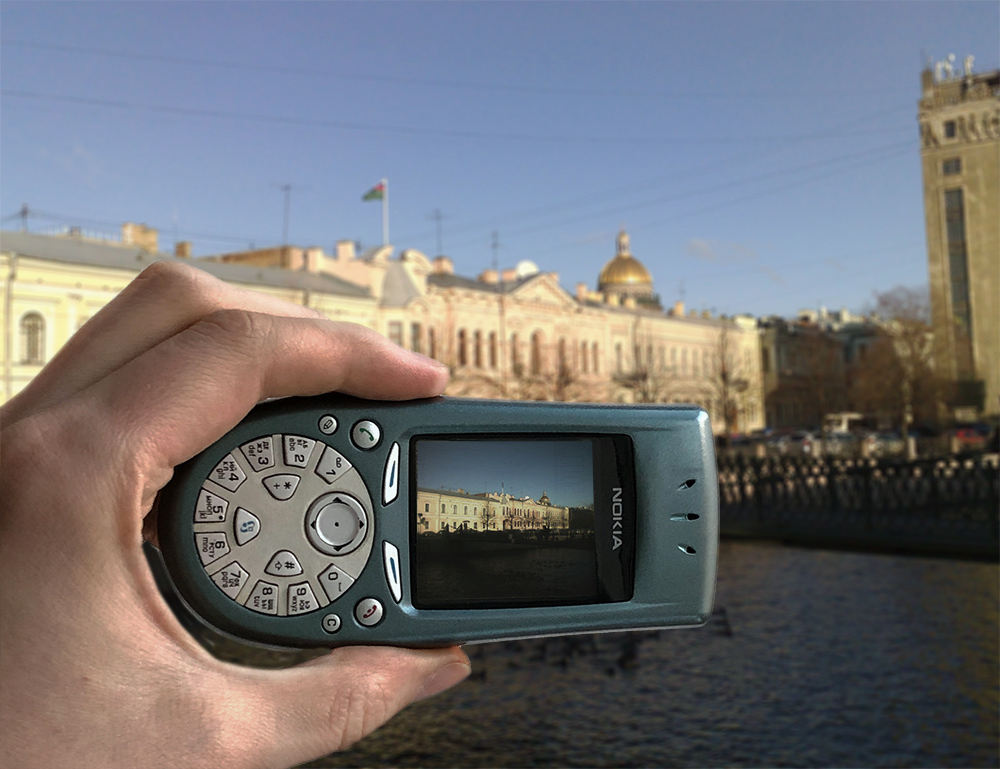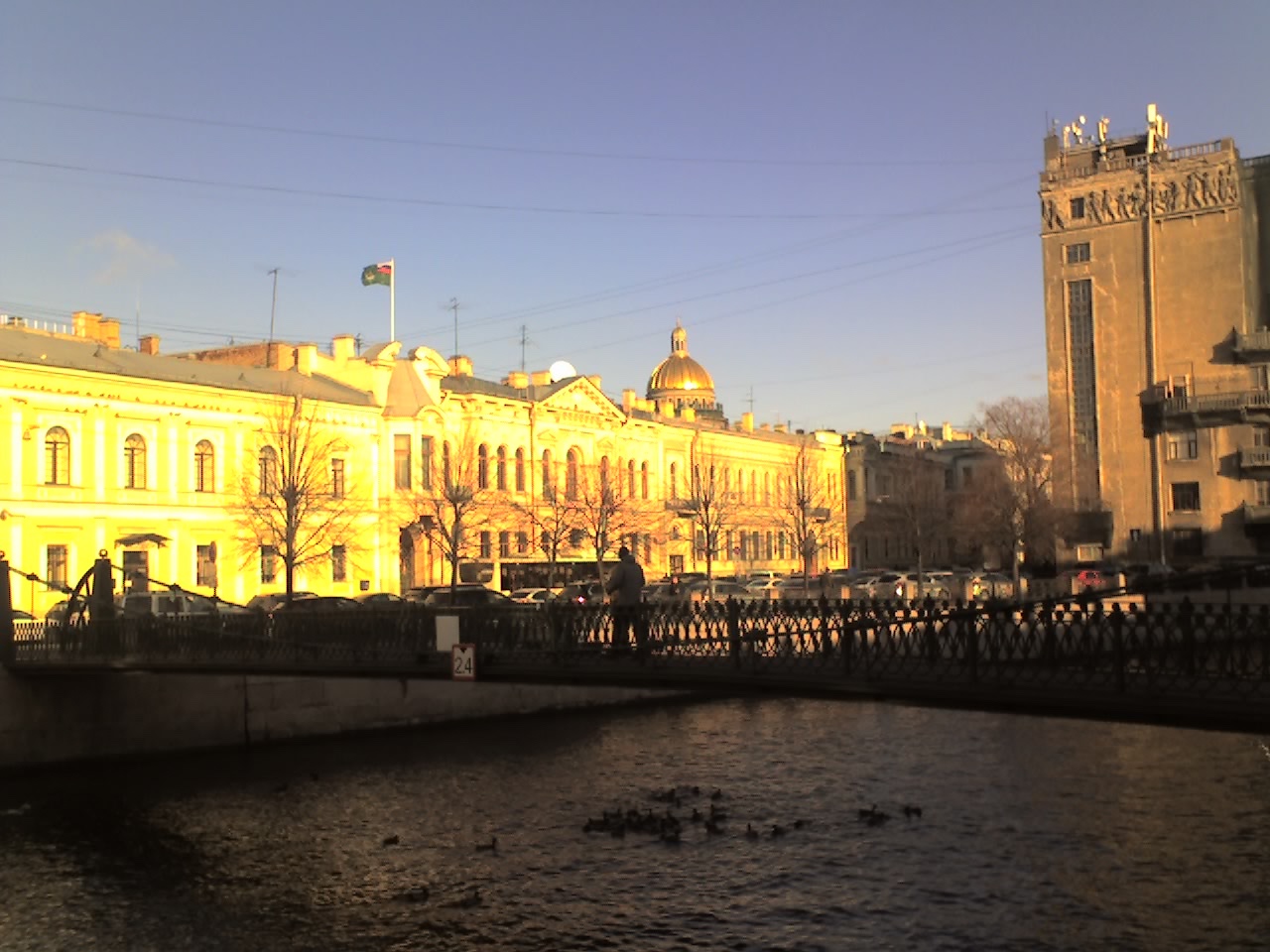
While I'm drawing a continuation of the illustrations of old phones, I found cameras with cameras in the collection and decided to do a comparative test and see how the progress was. The results were quite interesting. Plus tell about the history of the creation of these tubes.
The presence of a camera in the phone was considered something prestigious, although at first the quality was ridiculous. The first camera phone was the Kyocera VP-210. He came out in October 1999 in Japan. The device was equipped with a 0.1 megapixel CMOS sensor. Following it was released at the end of 2000 Sharp J-SH04. The model had a color STN display with 256 colors and a weight of only 74 grams. In 2002, the first European camera phone from Nokia appeared on the market - Nokia 7650 with a 0.3 megapixel camera. It allowed you to save a photo and immediately transfer it via MMS.
Nokia 3650, 2003

Camera 0.3 Mpx. Pictures of 640x480. Three shooting modes: Normal, Portrait (resolution 80x96) and Night.
As soon as the Nokia 7650 smartphone appeared, it immediately became a landmark product, by and large, this is the first Symbian device, which, thanks to the right marketing policy, was a resounding success. But there are no perfect solutions in the world, and the Nokia 7650 was not without flaws. Naturally, rumors soon appeared that an updated Nokia 7650i model would soon appear. The model really appeared, but it was called Nokia 3650, it is positioned as a smartphone for young people, and by no means a business of users. The reasons for this should be sought in marketing, since sales of 7650 at that time were already large, the updated version could not gain the same popularity in its class (business).
The solution was found instantly, because at that moment there was a youth segment on the rise. This explains most of the design features of this model, in particular, a bright color scheme, the presence of interchangeable panels. So, the device was produced in three colors - Dark Blue, Gray and Yellow, additional panels - Blue, Fuchsia, and Purple.
For the youth audience, the company decided to make the design of the device even more attractive and instead of the standard arrangement of keys, applied retro design when the number keys are arranged in a circle, like in an old disk apparatus. By the way, such disk devices are not new for Russian users, until the 90s the vast majority of landline phones had this design.
Nokia 8800, 2005

Camera 0.5 Mpx. Pictures 800x600, 120x144 (portrait mode, resolution increased compared to 80x96 in previous models). The camera settings are ascetic, there is a night mode, three types of image quality.
Nokia was preoccupied with creating a premium segment model at the very beginning of its existence, but real attention was paid to this pressing issue only in 1996. At that moment, a historic decision was made to create a premium model that differs from the phones on the market, both in the form factor and in the materials used to create it. The task set for designers and engineers did not look easy. On the one hand, there was an element base on hand that was not distinguished by the miniature components, on the other hand, the size of the future device and its weight should have become minimal among all devices on the market. Especially for the new project, the development of an internal antenna, a radio unit, and experiments with various materials began. Very quickly, designers came to the conclusion that the device should attract attention with a chrome surface, even better if it is made of metal. But the limitations of technology did not allow to create a metal case and fit into the weight limit, as a result, plastic with spraying was used, which created the appearance of metal. General management of the project was carried out by the head of design bureau Nokia, Frank Nuovo (Frank Nuovo).
The model was named Nokia 8810, the official announcement followed on March 18, 1998 at the CeBIT exhibition in Hanover. The audience enthusiastically accepted the new product, it’s enough to recall the expectation of sales and the absence of any competitors in general for this model. For the first time, it was for this device that online advertising was placed.
A continuation of the Nokia 8810 can be considered a model of the Nokia 8850, which was shown to the public on June 21, 1999. The similarity of design, the coincidence of many characteristics did not make the sequel as popular as the Nokia 8810, but this device was also successful. He remained on the market until the end of 2001.
The next step for the company in the premium segment was the introduction of "titanium" models, in particular the Nokia 8910. Sputtering was also used here, but technology allowed us to make it much better in comparison with the Nokia 8810/8850. Many users firmly believed that they had a metal phone, and there was practically no plastic in it.
History has the ability to repeat itself, this statement perfectly illustrates the fate of the Nokia 8800 model. During its development and promotion, exactly the same principles were used as when creating the first device of this family - Nokia 8810. The model was originally created with an eye on this device, most of the ideas which were used, came from that time and became possible to implement at a new technological level. The body material in the new device is now the most metal, plus in the spirit of the latest trends, the device has become a slider. This is the most winning form factor for the premium segment today. All other things remained for Nokia 8800 exactly the same as for the previous model, adjusted for the present.
Motorola RAZR V3i 2005

Camera 1.23 Mpx. Pictures 120x160, 240x320, 480x640, 960x1280.
You can set the exposure from -2 to +2, choose the type of lighting (auto, sunny, cloudy, indoor, office). There is a timer shooting.
Market entry of the Motorola RAZR V3 model has opened a new page in the history of mobile phones, has formed a fashion for subtle decisions. Most manufacturers in a hurry began to create their own RAZR counterparts, some models with one or another design element were similar to V3. RAZR sales can be safely called record for a device of this class, due to which Motorola's positions in many markets have strengthened. In the future, to increase the life cycle of the device, the company introduced other color solutions - black, and “female” pink (advertised by Maria Sharapova). Soon, the Motorola V3i appears, an apparatus that, with the help of cosmetic tricks, is slightly improved in comparison with the basic version. New features in the software are added, a memory card appears and a megapixel camera is right there.
Why was the Motorola RAZR V3 so in demand? Functionally, the model repeated the existing solutions of the company, for example, Motorola v600, but offered a new, unique design. By design, we understand both the materials of the case, and its thickness, the general appearance of the device. There was nothing like this on the market, as a result, the model’s functionality faded into the background, it was bought for the sake of design and unusual perception. It is this factor that has become the main one in RAZR sales. For V3i, the novelty of the design impressions is completely absent, it is essentially the same RAZR. For many, the functionality of the device came to the fore in this case, but it was inferior to modern solutions from many manufacturers.
Nokia 8600, 2007

Camera 2 Mpx. Pictures 160x120, 320x240, 640x480, 960x1280, 800x600, 1280x960, 1280x1024, 1600x1200.
The choice of white balance, effects (normal, false colors, shades of gray, sepia, negative, overexposure). The presence of a camera in a model of such a plan is nothing more than a tribute to fashion and nothing more. That is why the digital module has only a nominal value and does not pretend to have a good quality of shooting.
Nokia had no competitors in this price category. Of course, every self-respecting manufacturer had fashion models, but not one of them is able to emphasize the status of the owner as representatives of the Premium segment of the Finnish telephone giant did.
That's why many owners of Nokia 8800 and Sirocco were ready to stay on the crest of the wave and follow the fashion, in the creation of which Nokia was actively involved. And now, when the Nokia 8800 Sirocco Edition hit the store shelves less than a year later, another unique embodiment of engineering and design thought, referred to as the Nokia 8600 Luna, saw the light of day. It would seem that the destiny of this model is to be the flagship of the Premium segment. But, not so simple. It turns out that the new product is deliberately positioned below the notorious Nokia 8800 Sirocco Edition. This is evidenced by the low price of 250 euros, and the lack of advertising hype that sufficed around Sirocco, as well as the fact that Luna did not create a unique soundtrack. The latter fact, as we know, is a unique calling card of these models. Thus, we get some branch from the line.
This time, developers also paid great attention to materials and their decoration. Here's what Haikki Norta, senior vice president of Nokia Mobile Phones, says: “The utmost attention to detail has characterized every step in the development process of the Nokia 8600 Luna. “We have put a lot of effort into guaranteeing an amazing feeling from every surface - be it smooth glass, warm stainless steel or a nice-to-touch keyboard.”
Nokia N95, 2007

Camera 5 Mpx. Pictures 640x480, 1024x768, 1600x1200, 2048x1536.
From the settings: automatic exposure and manual from +2 to -2EV in increments of 0.5, white balance, choice of shooting mode (automatic, sports, custom, macro mode, horizontal orientation, night shooting, portrait), sharpening (Soft, Normal, Hard) and color tones (normal, sepia, black and white, distinct, negative)
The first spy photos of the “N95-like” device were signed by Nokia N83. Given the long-standing existence of the Nokia N80 at that time, it could be assumed that the N95 would be an improved version of the first. But a little time passed, and the confusion disappeared: along with the new N95 index, the novelty received the status of the N-series flagship.
The Nokia N95 has been recognized by EISA, the European Consumer Electronics Association, as "Best European Media Player of 2007-2008." EISA’s initial comments were terse: “Nokia N95 has all the options that can fit in a mobile device.” True, the following statements by the jury were more common: “This is no longer a mobile phone and not a status gizmo. Get your hands on the Nokia N95 and you will have the subject of communication art in your hands - the perfect way to be on the crest of a world wave. ”
At the first glance at the Nokia N95, a strong association with the Nokia N80 is created: the same form factor, a very similar keypad, even the arrangement of the lenses of the VGA cameras practically coincides. However, something similar N95 and N73, we are talking about stereo speakers, two-tone design of the housing (the battery compartment covers of both devices are made of the same material and differ only in the shape and location of the latches) and similar displays. The rear view makes the Nokia N95 akin to a digital soap box: there is a lens with a shutter and a flash window. The affiliation of the smartphone to the entire N-series give rounded corners - a signature touch of Nokia designers.
Sony Ericsson T700, 2008

Camera 3 Mpx. Pictures are 640x480, 1280x960, 1632x1224, 2048x1536.
There are effects (bw, sepia, negative), white balance adjustment, photo quality selection and adding date and time to the picture.
Back in 2007, the exhibition of mobile technologies revealed to the world the delicate music product Sony Ericsson W880i, in which the thickness of the case seemed minimal and the filling maximum. It's funny, but then the phone seemed tiny, and its face faces did not inspire any negative thoughts. But a year passed, and the W890i came out, where they trimmed all faces, made an aluminum case, achieved ultra-light weight, and fixed the main problems of the predecessor for the final touch. The result was a "sweetie", which also adequately brought down the price range to the output value of the W880i. Everything looked wonderful, but the demand for the new product turned out to be lower than expected, and the reason for the modest sales, many called anything but the price. And now, more than six months have passed, when the T700 appears on the market, in which Sony Ericsson has retained almost all the features of the W890i, and at the same time it has even split with the upper price range. If the W890i is almost completely made of metal, then in Sony Ericsson T700, to reduce the cost, the use of metal is minimized. Dimensions, functionality have not changed at all, so for lovers of miniature, thin solutions there is an excellent alternative to the W890i at a more affordable price.
iPhone 3gs, 2009

Camera 3 Mpx. 2048x1536 shots.
In iPhone 3Gs, it became possible to manually set the focus point: click on the desired area and the focus moves, everything is very fast and clear. This is true for both photos and videos. Such a pleasant trifle.
iPhone 3g was a real test for Apple: in a record time, the company had to solve many problems that arose when working with the first iPhone, and to develop a device that could conquer the most demanding mobile users, accustomed to the latest technologies - for example, in Japan.
For business users, one of the most important innovations was the inclusion of support for Microsoft Exchange ActiveSync and Apple MobileMe services on the iPhone 3G, which make it possible to synchronize and exchange calendar information, contact list and email. Thus, users who need such features have lost their motivation to purchase smartphones and communicators with BlackBerry and Windows Mobile.
Manufacturers of mobile phones, smartphones and communicators have taught us that the new is almost always very different from the old. The new device should have a number of very serious differences. It was unusual when someone does not do like everyone else and does not "roll out" a line of three different devices for a different audience, but is engaged in a completely different one. With what? Well, for example, bringing to mind the existing operating system, which is used in both phones and players. Updating the iPhone OS 3.0 brought so much for Apple devices that another manufacturer would turn it into a huge marketing buzz. Another company for the new "firmware" would present a whole line. But Apple has a different approach - every user of even the very first iPhone, even the first Touch can get many new features.
Naturally, at the time when the announcement related to iPhone 3Gs began, everyone already understood everything, but did not fully believe that the company would dare to present all the same, only with a different speed of work.
In my opinion, the Nokia N95 handled the best, with a slight deviation in warmth, while the iPhone 3gs handled worse than expected.
The first part about old phones